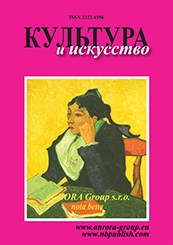Music and music culture
Reference:
Serov, I.E. (2021). Vocal Symphony of Boris Tishchenko. Culture and Art, 2, 1Ц11. https://doi.org/10.7256/2454-0625.2021.2.34981
Abstract:
The subject of this research is the monumental vocal-symphonic piece of the prominent Russian composer of the second half of the XX century Boris Tishchenko. His Symphony No.6 s based on the poems by A. Naiman, A. Akhmatova, O. Mandelstam, M. Tsvetaeva and V. Levinzon, completed in 1989, and tribute to Yevgeny Alexandrovich Mravinsky, who passed away a year before. Poetic lines that form the backbone of the symphony contain multiple images resembling death, which imparts a profound meaning, a moment of personal experience in dedication to the prominent conductor. Special attention is given to the symphonic dramaturgy of the Symphony No.6, the problem of interrelation between music and poetry, realization of the complex literary texts in the ultimately modern symphonism of Boris Tishchenko. The conclusion is made that Tishchenko is absolutely seamless in this vocal-symphonic opus and reveres his coauthors. The translates everything into the music, without missing a tiny thing that can reveal its meaning and beauty. At the same time, the circle of poetic images, semantics of the verse were transformed in accordance with his worldview. The novelty is defined by the fact that this article is first in Russian musicology, to comprehensively analyze the Symphony No.6 by Boris Tishchenko, reveal its semantics, and performance difficulties. The author attributes this symphonic composition of Boris Tishchenko to most remarkable in the history of Russian music.
Keywords:
symphony orchestra, contralto, soprano, poetry, vocal symphony, Eugeny Mravinsky, Boris Tishchenko, word and music, Anatoly Nayman, Leningrad
Aesthetics and theory of art
Reference:
Kormin, N.A. (2021). Thinking in colors . Culture and Art, 2, 12Ц38. https://doi.org/10.7256/2454-0625.2021.2.34996
Abstract:
This article reveals the philosophical grounds of the aesthetics of color, analyzes the correlation between the structures of philosophical and artistic comprehension of coloristics. Interaction of philosophy and art as the forms of cultural identity manifests in the sphere of intellectual understanding of the perception of color and its semantics in painting. In the hidden logic of contemplation of color, can be traced the outlines of the problematic of transcendental and intelligible in art conditions for the aesthetic approach towards chromatic space. Color creates the visual beauty, thus it is apparent why the aesthetic knowledge seeks to clarify to which extent we can assess the experience of color – the result of coloration of light. The art itself creates the so-called color ontology of the world. First the first time, the beauty of color and its perception are analyzed in the context of correlation between art and transcendental traditions of philosophizing (Descartes, Kant, early Husserl – his work “The Philosophy of Arithmetic”) that allows matching the key to a new interpretation of the tradition of color. Determination of its meaning requires comparing history and structure of the philosophical and artistic metaphor of color. It is demonstrated that the phenomenon of color is of crucial significance for the aesthetics, as it implies not only comprehension of the problem of correlation between nature and art, but also cognition of the beauty of color, its universal value for all forms of art, profound structures of perception of coloristic phenomena, picturesque unveiling of the color harmony of the painting.
Keywords:
Rilke, Husserl, Kant, Descartes, color, painting, art, philosophy, aesthetics, Kandinsky
Culture and cultures
Reference:
Liu, ..Y., Aleksandrovna, F.N. (2021). The peculiarities and problems of cultural tourism in the free economic zones of China. Culture and Art, 2, 39Ц55. https://doi.org/10.7256/2454-0625.2021.2.35006
Abstract:
Many cities in China currently have a reputation of international centers of tourism. For example, Beijing simultaneously draws attention as a city of centuries-old history and a modern cultural center. Other cities, such as actively developing free economic zones (Shenzhen, Shanghai, Tianjin, Hong Kong, etc.) initially did not have cultural uniqueness that would form the cultural brand of the territory and turn them into a remarkable cultural center. This hinders the development of cultural tourism in these territories. The goal of this article consists in determination of the peculiarities and problems in the development of cultural tourism in the free economic zones of China, using the example of Shenzhen, Shanghai, Hong Kong and Tianjin. It is established that such peculiarities and problems is directly related to the fact that initially these zones had more of an economic orientation. On the one hand, this provides financial resources and makes these territories potentially promising for the development of cultural tourism; while on the other hand, it sets back the cultural component, focusing on the different forms of tourism, namely economic shopping tourism. It is emphasized that the key characteristics of the development of cultural tourism consist in creation of infrastructure for the cultural tourism and availability of resource for cross-cultural communications and multicultural tourism. Among the relevant problems of the development of free economic zones, the author notes the slower development of cultural tourism compared to the economy and economic tourism; lack of perception by the local authorities of the value of cultural tourism and integration of its resources into the development of free economic zones, insufficient scientific reflection on cultural tourism in these territories of China.
Keywords:
brand, cultural tourism, China, free economic zones, Hong Kong, feature, Tianjin, Shanghai, Shenzhen, problems
Culture and science
Reference:
Rozin, V.M. (2021). Evolution of representations on reasoning (three cultural starts) . Culture and Art, 2, 56Ц64. https://doi.org/10.7256/2454-0625.2021.2.35142
Abstract:
This article analyzes the three cultural starts of reasoning (ancient, modern, and current). This analysis is preceded by the history of studying reasoning in the Moscow Methodological Group, the representatives of which set the task of creating the theory of mendacity, but failed to complete. It turned out that reasoning cannot be reduced to activity not explained by semiotics. The concept of Aristotle's reasoning (the first start) is explored. He completes the tradition of norming the discursive types of activity (reasoning, proof, cognition) that comes from Parmenides and Socrates, attributes the ability to reason to an individual, and along with Plato generates a new reality in mentality. The second start of reasoning is attributed to the Modern Age, which outlined the task getting hold of nature and formed a New European creative personality. In this case, reasoning is endowed with the characteristics of constructiveness, projectivity, eventfulness, perceived as a method of creating new nature and thingness by a person, and included into the context of formation of the culture of modernity. The third start, as the emergence of a new type of reasoning, is currently developing. It is substantiated by the crisis of the culture of modernity, which caused the emergence of new types of discursive practices (interdisciplinary research, collective forms of mental activity using the Internet, development of methodology). These new types of practices require further research and norming, so are the new functions and peculiarities of reasoning.
Keywords:
objects, concept, schemes, signs, cognition, evidence, reasoning, activity, thinking, culture
Scenic arts
Reference:
Shinzhina, A.I. (2021). Altai National Dance Theater УAltamФ as a laboratory of practical implementation of the results of research work on studying traditional culture of the Altai people. Culture and Art, 2, 65Ц79. https://doi.org/10.7256/2454-0625.2021.2.34621
Abstract:
The subject of this research is the analysis of choreographic art of the Altai Republic in the context of reconstruction of the concepts of traditional culture of the Altai people on the example of the State National Dance Theater “Altam”. Relevance of the selected topic lies in the fact that Altai dance is studied virtually for the first time. The article reviews the traditional culture of the Altai people, namely dance culture. The goal is to examine Altai dance as an independent form of choreographic art in reconstruction of the artistic stage imagery. The theoretical and practical significance consists in proving the relevance of analysis of the activity of the Altai Dance Theater “Altam” as a laboratory of practical implementation of the results of research work on studying traditional culture of the Altai people. The acquired results on the development of choreographic art in the Altai Republic give a better perspective on the artistic-imagery structure of stage performance. The methodological framework is based on the art, historical, and comparative methods that allows clarifying the specificity of development of the Altai folk choreography in the context of ethnic theatrical art, as well as revealing the peculiarities of such organics in creating the artistic-imagery structure of stage performance. Scientific novelty lies in the attempt to generalize and analyze the sources for studying the Altai dance. The author traces the evolution of the national choreographic art, beginning with the folklore origins. The article introduces into the scientific discourse the factual material, such as examination of dance elements in petroglyphs, folk epic tales, folklore, cultural rites, folk games and songs. The author observes the transformation of the indicated range of sources in various genres of national choreography. The analysis of ethnic creativity of the Altai National Dance Theater “Altam” demonstrates that for many years Altai dance integrates the typical for Altai people motions, poses, gestures, substantiated by ethno-genetic identification. The article directly connects the traditional Altai dance and formation of the Altai folk stage dance for the purpose of establishment and development of the professional choreographic art of the Altai people.
Keywords:
ethnic creativity, musical and drama performances, theater, stage art, Republic of Altai, Dance Theater, Choreographic art, dance culture of Altai, national choreography, laboratory for practical implementation
 This work is licensed under a Creative Commons Attribution-NonCommercial 4.0 International License.
This work is licensed under a Creative Commons Attribution-NonCommercial 4.0 International License.
 Eng
Eng












 © 1998 Ц 2025 Nota Bene. Publishing Technologies. NB-Media Ltd.
© 1998 Ц 2025 Nota Bene. Publishing Technologies. NB-Media Ltd.




